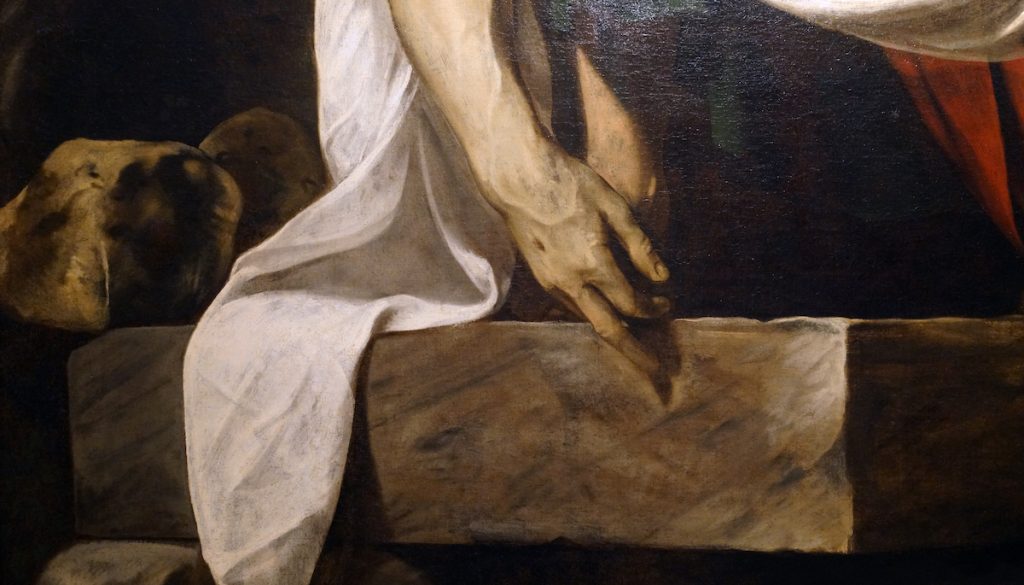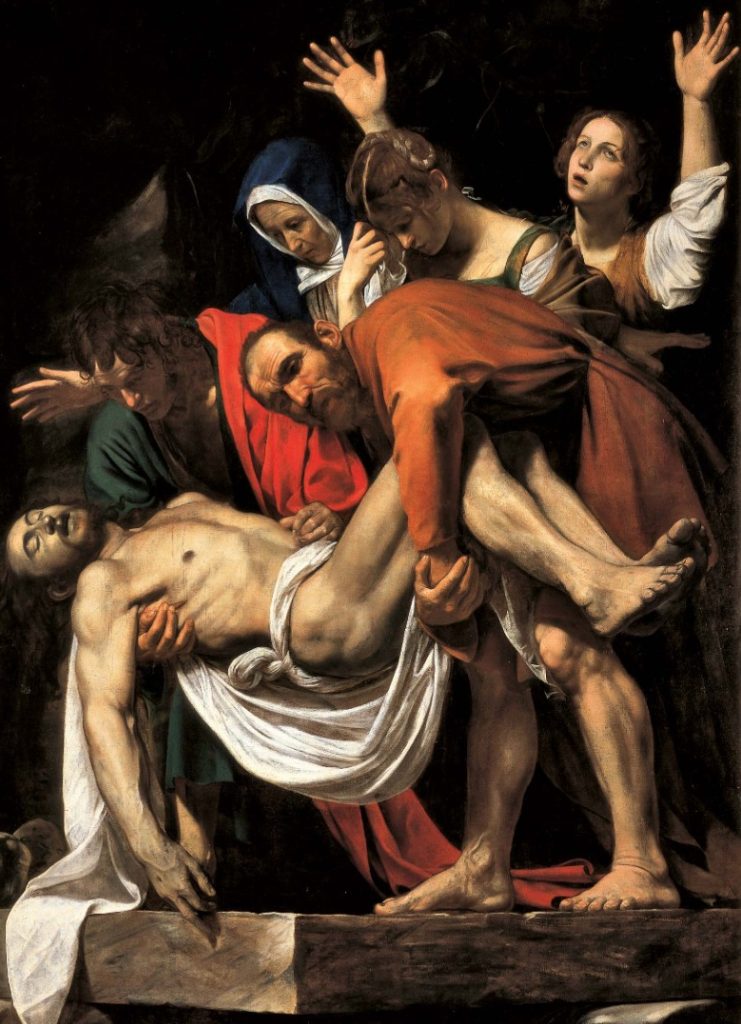Caravaggio, Deposition (or Entombment)

The subject
After the crucifixion, some of Christ’s followers (Nicodemus, Joseph of Arimathea, Mary Magdalene) along with his Mother, remove Christ’s body from the cross and place it in the tomb.
One of the first things you might notice about Caravaggio’s style, and we see it here in his painting of the entombment, is the darkness. There’s actually a word for it: tenebroso, which means dark or gloomy. Caravaggio painted this scene as though it was happening in the black of night with almost a spot-light effect on the figures. (Doesn’t it look like a dark stage that has been illuminated with a spotlight?)
There are several things that are important about this. There is no background—only darkness. No architecture, no landscape, and so as a result, we focus on the figures who are all located in the foreground of the painting. The spotlight effect of the lighting is very dramatic, and so we have very stark contrasts of light and dark. In other words, where modeling is usually a slow movement from light to dark, here we have very dark shadows right next to areas of bright illumination. The effect is very dramatic.

The space
Everything is located very much in the foreground of the painting, very close to us in fact. Look at Christ’s body—it’s so close we feel like we can touch it. And look at the ledge of the tomb, it is foreshortened and so it juts out into our space. And look at the elbow of the figure in orange carrying Christ’s legs—it is foreshortened, too, and so it pops into our space. One of the main characteristics of Baroque art is the breaking down of the barrier between our space and the space of the painting, so we feel like we’re part of it. Baroque artists use foreshortening frequently.
The composition
Baroque artists were also interested in movement. Here we see the moment when Christ is being lowered into his tomb. It’s a process happening before our eyes—so we have a caught moment in time. We see that the figures form a diagonal line—another very common feature of Baroque art. In the High Renaissance we saw compositions in the shape of a pyramid—a very stable shape. Here in Baroque art we see diagonals, or sometimes interlocking diagonals in the shape of an X.

Caravaggio organized the composition so that it looks like the body of Christ is being lowered right into our space, as though we were standing in the tomb. One of the most important goals of Baroque art is to involve the viewer.
Realism
Baroque art also tends to be very real—not only do the figures look “regular,” but the artist is giving us a very real sense of this moment. The body of Christ looks truly dead, the figures struggle to hold the dead weight of his body and ease him down gently into his tomb.

The figures are all very ordinary looking, they are not idealized at all, like the figures of the High Renaissance. Look at the figure holding Christ’s legs. His feet and legs are so ordinary looking—you can almost imagine the bottom of his feet being dirty. Even Christ looks rather like an ordinary man. They are figures we can relate to more—unlike the perfect figures of the High Renaissance.
Notice the figure who carries Christ’s shoulders. He has his arm under Christ’s torso and his fingers, as they reached around Christ, slipped into the wound that he received when he was on the cross (Christ was stabbed by a Roman soldier in the ribs). This may cause us to feel squeamish—but that’s the idea. Baroque art wants to get to you in your body—so you really feel it. When you know something in your mind it is one thing—but when you experience it with your body it is really different. Baroque art often wants you to have an experience that’s located in your body.[1]
- Dr. Beth Harris and Dr. Steven Zucker, "Caravaggio, Deposition (or Entombment)," in Smarthistory, July 19, 2015, https://smarthistory.org/caravaggio-deposition/ ↵

